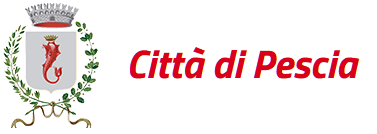
Colleviti, the hill above Pescia and The New Flower Market
Itinerario: Il convento dell'Osservanza di Colleviti - Villa Guardatoia - Villa Pupilli - Collecchio - Chiesa di S. Vito e Modesto - Monte a Pescia - La Chiesa di S.Bartolomeo - Villa delle Rose - Chiesa di S. Maria Assunta - Il Centro di commercializzazione dei fiori dell'Italia Centrale.
Convento di Colleviti : Ingresso e chiosco interno
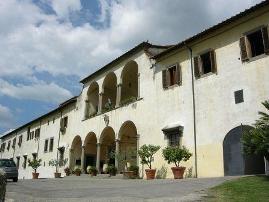
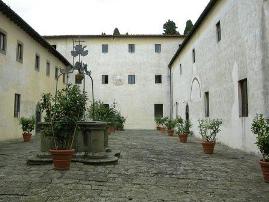
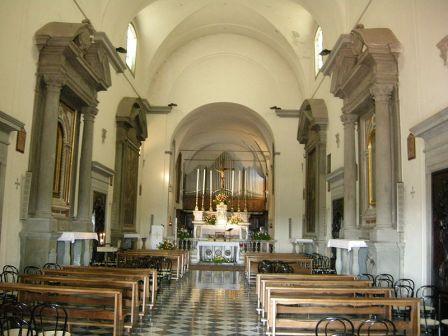
This tour invites you to the discovery of a relatively-unknown area in the environs of Pescia. It is about landscapes and sceneries, although the villages on route certainly have treasures and architecture. Let the beauty and the history seep into your soul.
South of Pescia, gently nestled on a green hill is the Convento dell'Osservanza of Colleviti, dated 1494 and dedicated to Saint Ludovicus, today the seat of a drug rehab centre. The approach is via a suggestive road, via Dante Alighieri, from via Galeotti by of the old flower market. Once on the hilltop, stop for a while and don't miss the spectacular view of the convent framed by high and solemn cypress trees. The name "Colleviti" probably refers to the prosperous vineyards ( hill is colle, and vine is vite ); yet Friar Dionisio (+1582) wrote that a local doctor explained him that the name meant "colle della vita", literally "hill of life".
The convent was completely restructured in the 1600 under the Grand duke of Tuscany, Cosimo III, in fact, was a very close friend to Father Guardian Serafino Giani, his confessor.
On the facade two rows of windows with a characteristic porch, the gateway to the convent and the church. The interior preserves noteworthy painting on canvas dated 1600s and 1700s; walk past the gigantic triumphal arch to the choir, and glance at the four large windows - two at either side - elegantly decorated with original frames. The altars, the confessional boxes and the pictures, all of them, tell the centuries-long history of the church. The early 18th-century high altar is marvellous with its splendid marble inlays. Last but not least, a reason for pride for Colleviti is the Franciscan Library, the most important in the whole Valdinievole. This place is worthy of a visit any time! Cruise along via Dante Alighieri, keeping the convent at the back, then turn left and reach the signposted crossroad to Collecchio and Monte a Pescia.
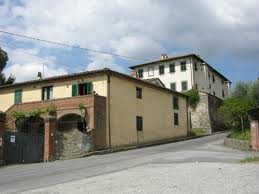
This is certainly not a boring drive, in fact, it is certainly one of the most scenic country roads extremely rich in breathtaking landscapes and splendid villas. It's a real joy for the eye. Just imagine that in the 1800s this area was compared to the magnificent Fiesole, a comune set on a scenic height above Florence. When the drive goes uphill steeply, look right at the imposing and strategically-located 17thcentury villa Guardatoia of the Cecchis, a monument to their incredible wealth and power. Enjoy strolling down the road, preferably early in the morning when you can get the best views of the country-houses. The road takes a sharper inclination now, so linger and relax for a while before venturing up- ward. This area was once called the cappella ( literally, chapel), because one stood here once.
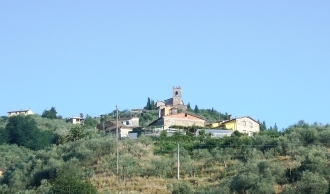
At a certain point the main road splits: left is the splendid 18th-century villa Chiari, and right is the sign-post to Collecchio and Monte a Pescia. Time to catch your breath at this view point after the demanding climb; allow plenty of time to admire the Uzzano hills and the castle. At the back, by the hill, the villa of the Pupillis will find your view. You really can't miss it, beautifully surrounded by centuries-old magnificent olive trees. Our short, winding drive ends in a spectacular setting, you are now in Collevecchio. Just relax and enjoy another one-of-a-kind vast panorama of endless horizons over Pesciatin Switzerland, but do take time to wander the lovely historical centre. Here stands the rettoria, literally rectorate, dedicated to the Saints Vitus and Modestus; the architecture is simple and the facade is missing, but inside you can see a beautiful painting by Passignano. It's lovely.
Continue on, past a small wood of chestnut and acacia trees, past two hairpin bends, which demand concentration, in the far distance slowly emerges the fascinating hilltop village of Monte a Pescia, once the seat of the most influential families, today an extremely picturesque little place with a few houses perched on a steep hill. One of the most pleasant, and hankered after places today, local historians of 1800s named it the Pesciatins' Florence. In ancient times the village was walled ans fortified and gained a certain importance when Valdinievole passed under Florence and the Mount became a strategic Florentine
stronghold bordering the Republic of Lucca. Well worth a visit is the rettoria of the Saints Bartholomeus and Andrew, renowned for the relic of the Saint Thorn from Jesus' Crown of Thorns. The interior was entirely renovated in the 18th century, a highlight is the statue of Saint Bartholomeus of Della Robbia School.
Back in the car, from Monte a Pescia easily return to town the way you came driving along the country-road which joins the village to the Castello di Bareglia and then to Pescia. Heading for the castle, watch out for the "sasso del vescovo", literally the bishop's stone, on the paving. In old times on the 24th august,
on Saint Bartholomeus' day, the bishop climbed up here to Monte, and used to rest on this natural seat.
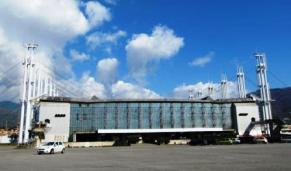
Continue on, past a small wood of chestnut and acacia trees, past two hairpin bends, which demand concentration, in the far distance slowly emerges the fascinating hilltop village of Monte a Pescia, once the seat of the most influential families, today an extremely picturesque little place with a few houses perched on a steep hill. One of the most pleasant, and hankered after places today, local historians of 1800s named it the Pesciatins' Florence. In ancient times the village was walled ans fortified and gained a certain importance when Valdinievole passed under Florence and the Mount became a strategic Florentine
stronghold bordering the Republic of Lucca. Well worth a visit is the rettoria of the Saints Bartholomeus and Andrew, renowned for the relic of the Saint Thorn from Jesus' Crown of Thorns. The interior was entirely renovated in the 18th century, a highlight is the statue of Saint Bartholomeus of Della Robbia School.
Back in the car, from Monte a Pescia easily return to town the way you came driving along the country-road which joins the village to the Castello di Bareglia and then to Pescia. Heading for the castle, watch out for the "sasso del vescovo", literally the bishop's stone, on the paving. In old times on the 24th august,
on Saint Bartholomeus' day, the bishop climbed up here to Monte, and used to rest on this natural seat.
Now, take the main road ( called Statale) and turn left to COMICENT , past Villa delle Rose and the 19th-century Villa dei Cedri del Libano, you get to the Chiesa S. Maria Assunta del Castellare (1879) which is well worth a visit. South, on the left is the imposing 40.000 sqm modern architecture of the COMICENT, the new flower market designed in the 1970s by the Florentine architect Leonardo Savioli. Should you like to visit it, even on a guided tour, call 0572 4401 - 453108

